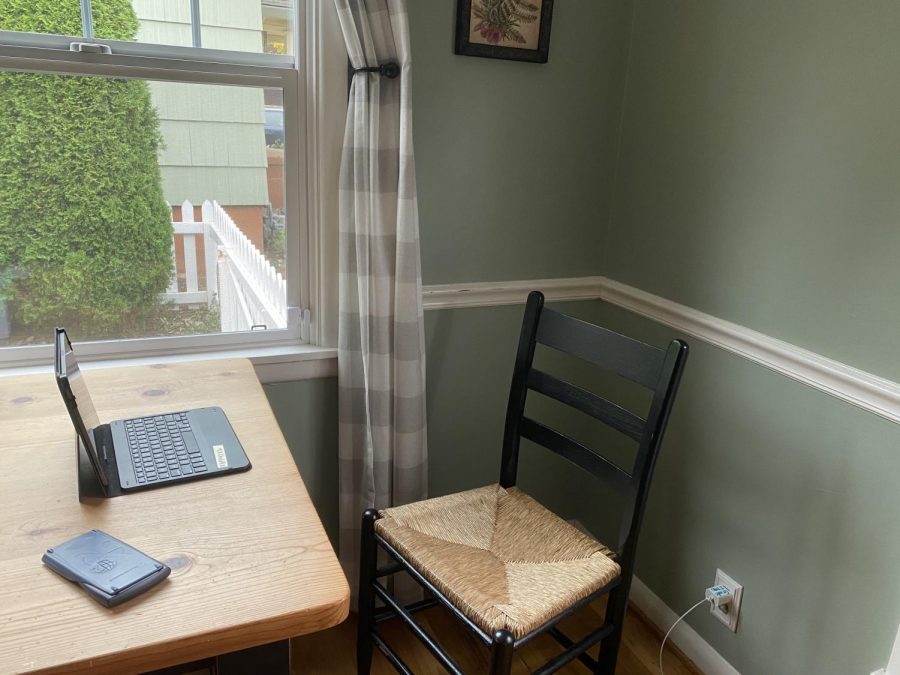A Glimpse Into Students’ Home Learning Environments
Photo courtesy of Grant Ellison
Junior Natalie Fuchs recommends that students “get a planner, and also probably minimize distractions,” to help stay on top of their assignments while learning from home.
September 30, 2020
In past years, high school classrooms have generally looked the same — metal desks in rows pivoted towards whiteboards, bins of organized supplies at one end of the room, and colorful posters plastered on surrounding walls.
However, this year, La Salle students, like many others across the country, have been forced by the COVID-19 pandemic to shift from learning in traditional school spaces to working at home, converting kitchen tables, bedrooms, dining rooms, and family rooms into makeshift classrooms.
Some students have arranged supplies such as pens, notebooks, and charging cables on desks or tables in their homes, while others have adapted to learning on their bed or floor, using resources on their iPads to help them stay organized.
For most students, new workspaces have posed some complications that make it harder to learn and connect with classmates and teachers. Students expressed difficulty balancing school and home responsibilities in one place, resisting distractions, facilitating meaningful class discussions through a screen, and accessing the resources they need from home.
“It’s hard doing [school] at home because when I’m at home my parents are usually at work, so I have to take care of my younger siblings,” said senior Alyna Nguyen, who usually works at a desk in her bedroom. “During my lunch break I have to make their lunches too, so it’s just kind of like balancing home and school now in the same place.”
Family obligations are just one thing diverting students from schoolwork while they are learning from home. Home workspaces are rife with other distractions too, like unrestricted electronics.
“I turned off all my notifications on my phone because, since there’s no teacher telling me to get off my phone, I really have to do it myself,” junior Natalie Fuchs said.
In addition to some of the distractions that at-home workspaces have created, students have also had to adjust to new methods of communication with classmates and teachers over a screen. Students say that while breakout rooms on Zoom can be an effective way to hold discussions for people who are especially social, they aren’t a perfect alternative to discussions in a traditional classroom.
“If everyone’s on mute and [has their] cameras off, you don’t know whether or not they’re actually listening, or if they’re actually there at all,” said sophomore Gabriel De Leon, who normally joins his Zoom classes from his bed.
Freshman Grant Ellison said that asking questions and communicating complicated topics has also been more difficult in his new workspace at home. Particularly, he expressed that it’s more difficult to find times to talk face-to-face with a teacher, and that “sometimes you just can’t get what you’re trying to say across in writing,” like through an email or Schoology message.
In elective classes, such as art, it can be a challenge to learn without having access to the array of materials that a classroom at school would offer.
Sophomore Stella Rask, who is taking Advanced Art 2D, said, “it’s just not as fun, and you aren’t as motivated to do [art] if you’re not proud of it and you’re not proud of the supplies you have.”
For freshmen specifically, at-home classrooms have made it even more challenging to form friendships with new classmates and relationships with unfamiliar teachers. Ellison, who describes himself as a very social person, entered La Salle knowing a few people, but was looking forward to meeting more. “It’s pretty difficult to actually make good friendships over digital learning,” Ellison said. “You can’t really connect in five minutes.”
While students’ new workspaces have created many obstacles, they have also provided opportunities for students to rethink some of their daily habits and the tools they are using to stay organized. Many students have been able to make adjustments to their space or their routines to make the transition to learning from home smoother.
Many students say the most helpful thing they have done to adapt to their new workspace is simply finding a routine that works for them.
For Fuchs, this has meant turning off all notifications from her phone, clearing her desk of any distractions, and developing a system for her planner that helps her better organize all of her assignments.
“I have pink for things I need to get done that day because they are due the next day, and then yellow is if I have an upcoming test, and then blue is just for if I have extra time,” Fuchs said. “If I don’t put any colors on them they’re low priority.”
While Fuchs has found reorganizing and using a planner helpful, Rask has found that switching her workspace from her bed to her desk has made digital learning easier.
“At the beginning of the year I definitely tried to do [digital learning] from my bed, just because I thought I’d be able to get work done, but I would just end up sleeping in between my classes and it was just a bad habit so I was like, ‘no, we have to fix this,’” Rask said.
Rask has also tried incorporating new practices into her daily routine, like waking up at least 30 minutes before school starts and making sure she has time to tidy her room before her classes. “Even if my class can’t see it, I just feel like it helps me stay more motivated and gives me something to be proud of,” Rask said.
Some students have found that adjusting to their new workspace has led them to develop better study habits.
“I really learned how to manage my time and how to be effective in doing my work, because now… my teachers can’t tell me to do it or force me to do it, so it’s kind of on me to get everything done,” Fuchs said. “So [digital learning has] really helped me stay motivated and stay on top of things.”
In light of the many challenges that digital learning workspaces have created, students have been making many beneficial adjustments. To help with the complications they can’t fix, students say they are doing their best to remain optimistic.
“I guess I’m just kind of keeping a positive mindset,” Ellison said. “And that’s all I can do.”





